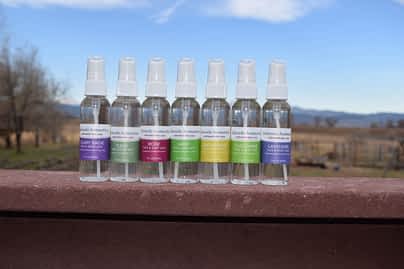We try to maintain our farm at about 1000 lavender plants. Although every year we lose many plants, we try to replant them to keep a steady number of plants. This year it seems a more significant loss maybe due to warm drying winds in the spring.
Types of Lavender
There are two main types of lavender grown in the US; Lavandula angustifolia and Lavandula x intermedia and within each of these species are hundreds of varieties that all have slightly different characteristics. Both are in the Mint family (Lamiaceae). They are native to the Mediterranean and love dry climates and rocky soils.
Lavandula angustifolia is sometimes called English lavender or even true lavender. We want to use the botanical name, though so that there is no confusion. Within the angustifolia species we grow the following varieties: Maillette, Folgate, Hidcote, Royal Purple, Irene Doyle, Melissa, Munstead, Buena Vista, and probably a few more that I have forgotten. My favorite is Folgate. It seems to do well in our climate (Colorado) and has long stems making it nice for bouquets. Royal Purple is a close second with it’s dark purple flowers.
The second species, Lavandula x intermedia is a cross between L. angustifolia and L. latifolia. It is commonly referred to as ‘lavandin’ and sometimes referred to as French lavender. It looks very similar and you would not notice the difference except that the plants themselves are sometimes larger and have longer stems. The scent is a little more camphorous than the angustifolia too.
In this species we grow the following varieties: Grosso, Giant Hidcote, Provence, Super, and Impress Purple. This species does not grow very well. I planted Provence the first year we planted and I think most is now dead. The Super is new this year so I am hoping it does well.

Distilling Lavender
We harvest and distill both species of lavender separately to produce hydrosol and essential oil. Many farms will also separately distill each variety. We have not done that yet, but may have enough this year to do so.
The main components of Lavandula angustifolia essential oil are linalool and linalyl acetate. These components give lavender it’s relaxing and anti-anxiety qualities. Although the main components of Lavandula x intermedia are also linalool and linalyl acetate, it also has high amounts of eucalyptol and camphor which give it a slightly harsher aroma. Nonetheless, it still has relaxing qualities, but is also used for respiratory effects.

Harvesting Lavender
We harvest lavender at three different phases. The first being when the buds just start to appear on the stem. We bundle and dry these and use them as buds for culinary purposes and in bath products and our Dream Pillows. When the flowers first begin to open on the bottom of the stem we harvest those for bouquets. These are great as fresh flower bouquets to have in the house or we dry them to use as dried flower bouquets. And third, after the flowers are in full bloom we harvest those for distillation.
Our main product of distillation is the hydrosol or the watery part of the distillation. We remove the essential oil floating on top and bottle the aromatic water portion sometimes referred to as a hydrosol or distillate water to use as a face and body mist. These wonderful sprays will tone, hydrate and refresh not only the skin, but the spirit. If you are feeling down, you will surely feel better after a few spritzes! We then use the essential oil in a variety of products, but never have enough of our own to use.

Lavender Products
If you are interested in any of our lavender products you can find them here. They include lavender soap (w shea butter), Lavender/Rose body oil, Lavender Mountain Mist hand/body lotion, Lavender/Rose Salt Scrub, Dream Pillows, Herbal Foot Soak, Green Tea Herbal Bath, Clear Creek Hand/Body Wash, Yarrow Oil Cleanser, and Lavender/Rose Bath Salts.
Are you pulled by the lure of lavender? If you are interested in growing lavender, check out the United States Lavender Growers Association. It was formed in 2012 as a trade organization for lavender growers. I am proud to have been on the organizing committee. There is also a Lavender Association of Colorado. Both groups are a great help to lavender growers.

Your resources above will help me to learn growing lavender. This is what I’m looking for. Thank you so much!